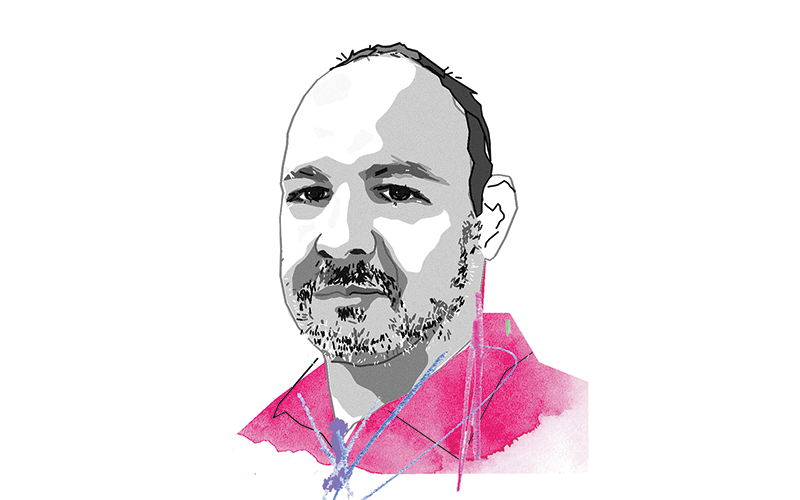
LET’S THINK ABOUT A DIFFERENT KIND OF CONTROL SHIFT. Before we break down the where, what and why of a digital foundation, we first want to make an important revelation. One that, at times, you may have realised yourself. And one that provides useful context on the importance of a digital foundation. It is this: control is an illusion. We have choices and we make decisions. With these, we do our best to affect the final outcome. So, here’s the rub: you are never fully in control.
When it comes to building your digital foundation, that’s ok. Actually, it is more than ok, because when it comes to making a palpable difference to people’s lives, embracing a lack of control is essential. Take the pandemic. Before it hit, how many organisations do you think were set up to adapt and cope with the new demands placed upon them? Few, we would wager.
It was those with the basis of a digital foundation already in place that could react more quickly, and meaningfully, to the needs thrust on them. From the deployment of collaboration tools to enable homeworking to the rapid development of applications allowing people to request services, examples of new ways of working – underpinned by a digital foundation – sprang up everywhere to support people during the crisis.
In a recent Society for Innovation, Technology and Modernisation conference, one chief executive stated: “Covid-19 accelerated the move to digital consumerism from months and years to weeks and even days.”
Those in the public sector have embraced new forms of digital working, engagement, collaboration and delivery – they had no choice. This means much of the fear factor around digital technology has disappeared. In fact, to an extent, people now expect to interact with their councils digitally.
That is not to say there aren’t challenges around digital inclusion, legacy systems, outdated (or out-of-reach) digital infrastructure and the lack of joined-up-ness between local government, healthcare and the voluntary sector. There is. Yet, the digital ambition in the public sector shapes how we live day today. And that is no bad thing.
A foundation for your imagination
Often, technology is brought in to control an aspect of how an organisation runs; to control an outcome. But the problem with this one-dimensional approach is that it constrains outcomes and limits what is possible. Successful outcomes become bound by the limitations of technology. But what if you removed the shackles of control? What if you were limited only by your imagination?
Rather than using technology to control an outcome, build a digital foundation on which to add technology that allows you to solve any problem. Sounds a little ‘far-out-there’, right? Yet it’s not. It is happening all around you.
For instance, Sunderland City Council uses Alexa-style assistive technology to enable residents, especially older generations, to stay in their homes rather than moving into the care system. “Push notices alert someone to take their medicine. And sensors in the home alert others that a family member has put a kettle on, so they know they are up in the morning. It provides reassurance and a safety mechanism, but also gives independence to the individual,” says Patrick Melia, chief executive of Sunderland City Council.
The benefits of a digital foundation
You may develop your foundation with a goal in mind. Yet the right platform will give you the flexibility to pivot if that goal moves.
During the pandemic, those with a well established digital foundation adapted to the crisis faster and with less disruption. They could deploy and scale new productivity, collaboration and utility software fast.
It is something we continue to see as organisations work to support people during the current cost-of-living crisis. You need a platform to enable you to move from linear responses and constrained outcomes, to one where you can react to changing demands without the need for expensive – and lengthy – technology implementations.
‘Rather than using technology to control an outcome, build a digital foundation on which to add technology that allows you to solve
any problem’
Take Suffolk County Council for example. It wiped millions from the annual cost of running school-bus services by using artificial intelligence to analyse route data and identify efficiencies, without affecting journeys. Children arrived at school safe and sound. And Suffolk allocated more funds to other areas.
So, what does a digital foundation look like? What are the building blocks of a digital foundation? The answer is that it depends on how far advanced you already are in your digital journey and on where you want to get to. This then dictates the make-up of your foundation: on-premises, cloud, or a hybrid mix of both, which brings us to an interesting cloud debate in the public sector. According to UKCloud, 85.2% of public sector organisations are reluctant to move applications to the cloud because of risk and security concerns. Yet, cast the net beyond the public sector and 64% of IT professionals agree that the cloud is more secure than older systems.
Better connected
Can control and security sit alongside flexibility and agility? We believe the answer is a resounding YES. You want your teams to have the tools to reach and engage and support more people in more ways, and for those people to have the means to connect with you. But running old software on old systems internally constrains what you can build to support this. Moreover, you don’t want it holding you back from progressing social cases, giving people the means to talk to you or from identifying vulnerable families affected by the cost-of-living crisis. Similarly, you don’t want to concern yourself with the repercussions of using software without correct licence use rights. You want to deliver proactive value and support and make a positive difference, rather than wasting time working out how to do so within the constraints of current systems, right?
This said, for some, having physical systems is good and right. You may have committed to long-term licences. Or you may store sensitive financial or customer information. Or maybe the cost and complexity of re-architecting applications is too great. In fact, basing your digital foundation on a hybrid model of on-premises and cloud-based platforms gives you flexibility.
You may choose to run your productivity tools – such as Office 365 – on an application platform in the cloud to ensure demand scalability. Yet, because of the sensitive nature of the information you handle, you may choose to manage your data systems on-premises. There is no right or wrong.
How to create your digital foundation
A digital foundation is not one thing, or another. It is a culmination of approaches coming together to enable the best outcome for the people you support.
You will need:
- A unified technology approach, to enable collaboration
- Easy to use tools, to enable personalisation
- A cloud architecture, to underpin applications.
And what it looks like is largely dictated by two things – where you are today and where you want to be tomorrow. Does this mean that by deploying productivity software like Microsoft 365 you have a digital foundation? Well, yes and no. It is certainly part of the digital equation. Running productivity software for the organisation in the cloud – and thereby making it easier to scale up or down – is sensible.
During the pandemic, such cloud software enabled many local authorities to scale up collaboration and service delivery, despite sending everyone to work from home. But it is only one part. Take Dorset Council for example. In 2020, it set a target of saving £18m by 2024. It aims to achieve this by following a four-year transformation plan, involving 38 projects that focus on removing effort, cost and process duplication, and on delivering a modern omni-channel experience via a new digital platform.
This platform will enable Dorset to improve efficiency and delivery of frontline services to 380,000 residents. “We have changed models and systems and processes to be customer focused, rather than implementing monolithic systems that meant the organisation or customers had to adapt to them,” says chief executive Matt Prosser.
This transformation will allow Dorset to save and redirect budget and focus on other critical challenges, such as reducing its costs and carbon footprint, or using evidence intelligence to direct decisions and deliver value, or tackling digital exclusion to reduce social disadvantage. “There is a chance for us to be commercial with a social purpose,” he adds.
With the right approach, building on a digital foundation can not only limit the impact of budgetary constraints but also allow you to address key issues as they arise.
Data, streetlights and saving lives
Have you ever found yourself nagging the kids to turn the bathroom or bedroom light off? Annoying, isn’t it? First there is the cost of lighting a room with no occupants. Then there is the wasted energy. Harrow Council reduced the cost of running streetlights by using embedded sensors. Each lamp, connected through artificial intelligence sensors, sends collected environment data to cloud servers for analysis. The result is that lights only turn on when necessary.
Having the right foundation can even be a matter of life or death. Sutton Council saved four lives by having data from linked sensors sent to emergency services. The sensors track patterns and changes in a resident’s living environment. When the temperature failed to rise beyond a certain point for a set period, indicating a lack of movement or activity, alerts were raised. A faster response time saved lives.
A digital foundation is a journey for everyone. Before you begin, know where you are starting from. For example, Isle of Wight Council began its digital reset journey by interviewing stakeholders across the organisation. It wanted to see how existing digital technology was used, which identified gaps and shaped the scope for improvement.
A good starting point
Whatever the output of such scope-setting, remember your digital journey must include the people consuming your services, not just those delivering them. Think of families living in hard-to-reach locations, elderly folk not using the latest tech, or visually impaired people requiring specialist support. Consider how they can interact with your digital services now and in the future.
You will need to prioritise and build your digital foundation incrementally and at your own pace. See what approach – cloud, on-premises or a mix of the two – gives you the best foundation from which to launch digital initiatives.
Aberdeen City Council uses chatbots to answer questions from the community. It responds to 200+ queries per day, relating to garbage collection, council tax, road and lighting issues and education, freeing staff to deliver value-adding initiatives.
For any authority striving to deliver on its own digital agenda, Dorset’s chief executive has this advice: “Listen and involve citizens, your elected members, and staff at every state. They’ll work with you to shape things that work.”
Building your digital foundation is a culmination of people, processes and technology coming together for a common purpose.
Andy Ventor is the public sector lead for HSO UK



















